MAC CONNER
Delaware Art Museum
June 24, 2017 – September 17, 2017
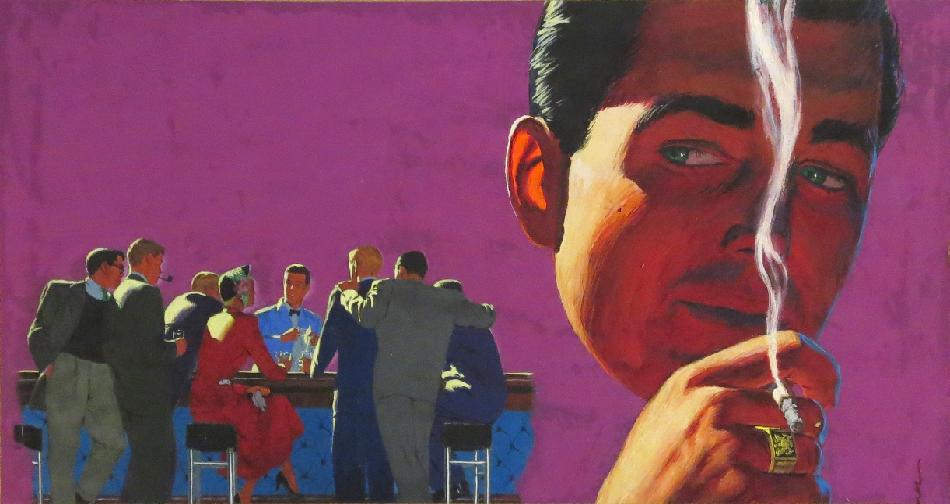 Illustration for “All The Good Guys Died” in Cosmopolitan, Gouache on paper on illustration board © Mac Conner. Courtesy of the artist
Illustration for “All The Good Guys Died” in Cosmopolitan, Gouache on paper on illustration board © Mac Conner. Courtesy of the artist
His work is a “time capsule” of an era when commercial artists
helped to redefine American style and culture
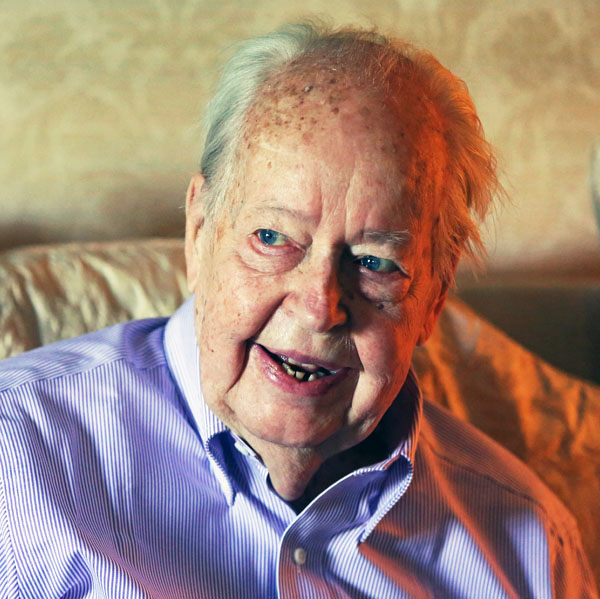 This comprehensive and lively installation explores the work of one of America’s original “Mad Men.” McCauley (“Mac”) Conner (born 1913) created advertising campaigns for a variety of products during the decade when the advertising industry was at its height and centered on Madison Avenue.
This comprehensive and lively installation explores the work of one of America’s original “Mad Men.” McCauley (“Mac”) Conner (born 1913) created advertising campaigns for a variety of products during the decade when the advertising industry was at its height and centered on Madison Avenue.
His illustrations for leading women’s magazines such as Redbook and McCall’s animated a wide range of popular literature, from romantic fiction and detective stories, to topics of import such as Cold War anxiety and juvenile delinquency.
McCauley “Mac” Conner turned 100 years old in 2013.
Photo courtesy of the New York Times.
 Illustration for “Where’s Mary Smith?” in Good Housekeeping, June 1950, Gouache and gesso on Masonite™ © Mac Conner. Courtesy of the artist
Illustration for “Where’s Mary Smith?” in Good Housekeeping, June 1950, Gouache and gesso on Masonite™ © Mac Conner. Courtesy of the artist
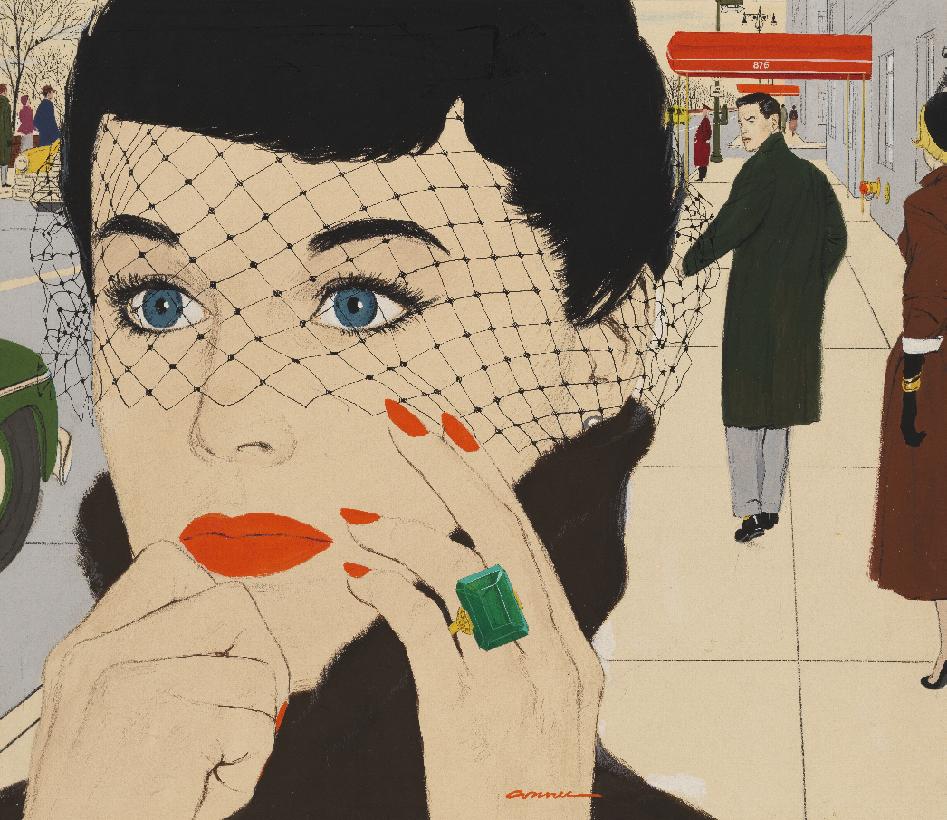 Illustration for “How Do You Love Me” in Woman’s Home Companion, August 1950, Gouache on illustration board © Mac Conner. Courtesy of the artist
Illustration for “How Do You Love Me” in Woman’s Home Companion, August 1950, Gouache on illustration board © Mac Conner. Courtesy of the artist
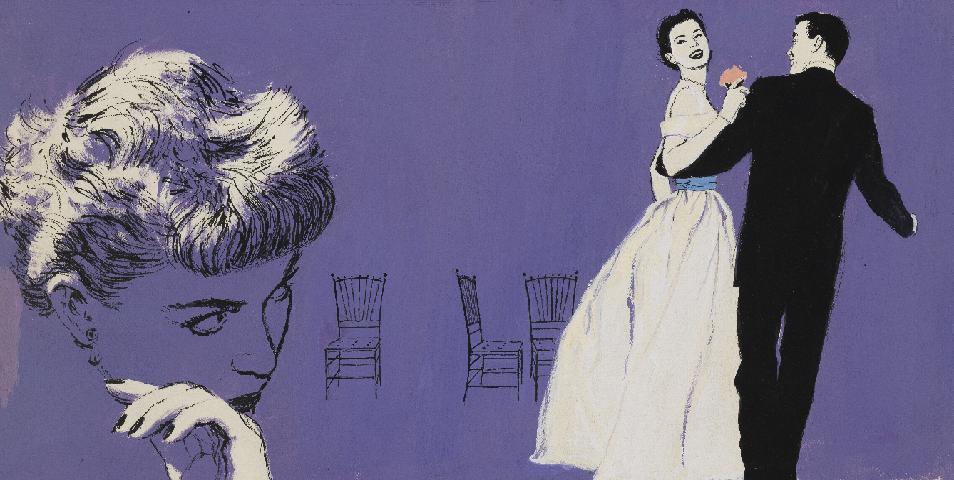 Illustration for “The Trouble With Love” in Good Housekeeping, August 1952, Gouache on illustration board © Mac Conner. Courtesy of the artist
Illustration for “The Trouble With Love” in Good Housekeeping, August 1952, Gouache on illustration board © Mac Conner. Courtesy of the artist
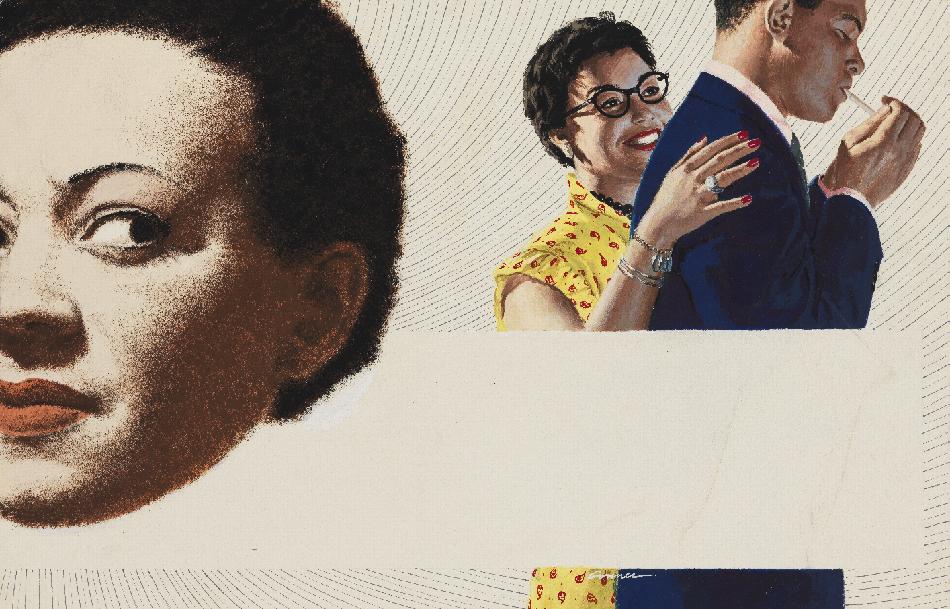 Illustration for “Don’t Be Like Me” in Collier’s, September 8, 1953, Gouache on illustration board © Mac Conner. Courtesy of the artist
Illustration for “Don’t Be Like Me” in Collier’s, September 8, 1953, Gouache on illustration board © Mac Conner. Courtesy of the artist
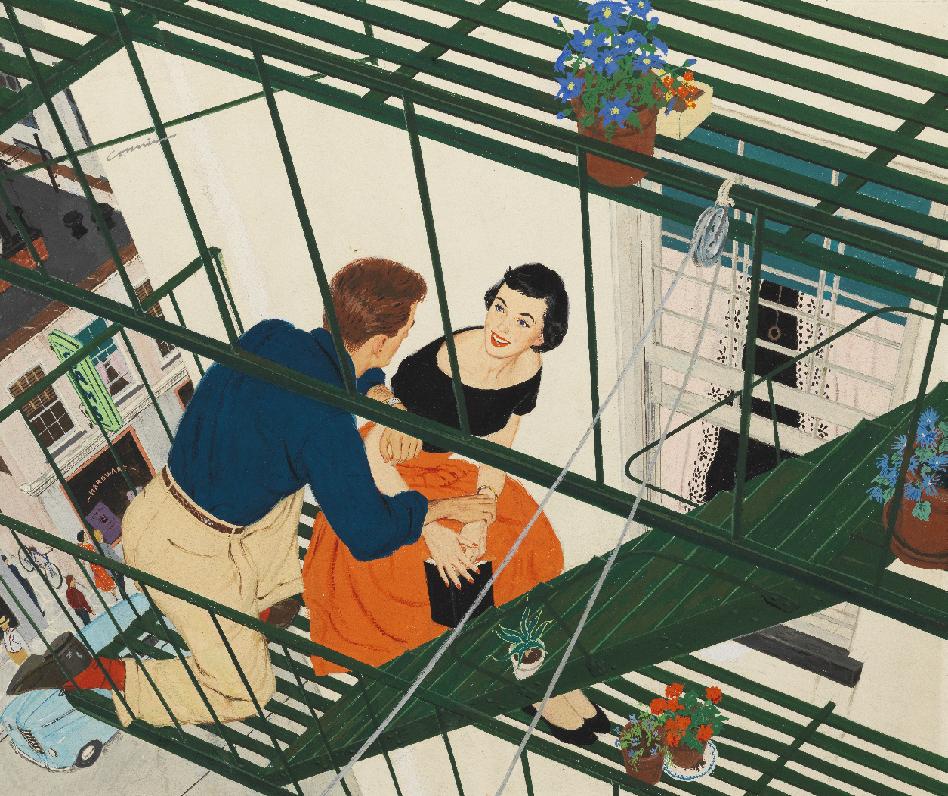 Illustration for “Let’s Take a Trip Up the Nile” in This Week Magazine, November 5, 1950, Gouache and graphite on illustration board © Mac Conner. Courtesy of the artist
Illustration for “Let’s Take a Trip Up the Nile” in This Week Magazine, November 5, 1950, Gouache and graphite on illustration board © Mac Conner. Courtesy of the artist
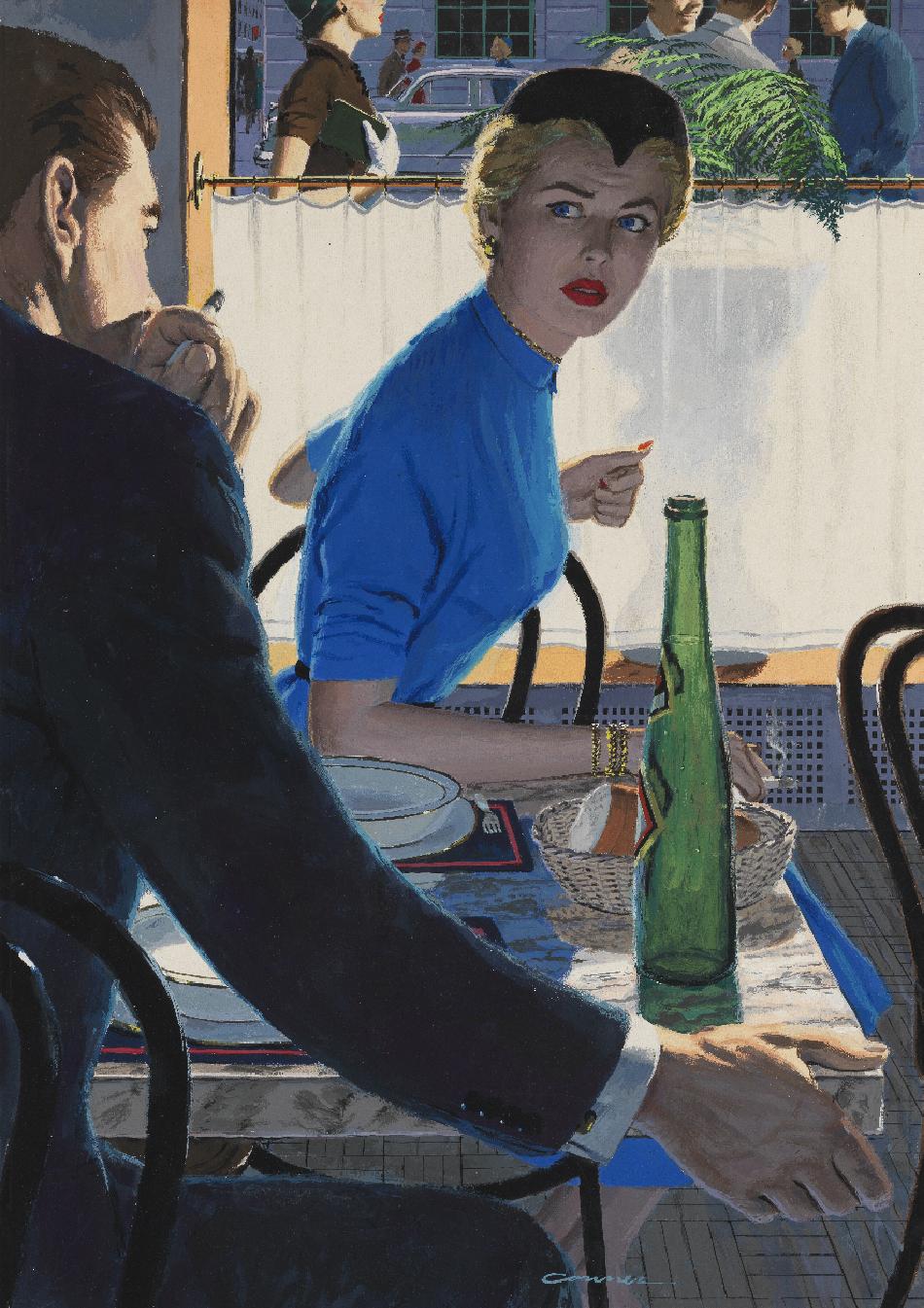 Illustration for “Strictly Respectable” in Redbook, August 1953, Gouache on illustration board © Mac Conner. Courtesy of the artist
Illustration for “Strictly Respectable” in Redbook, August 1953, Gouache on illustration board © Mac Conner. Courtesy of the artist
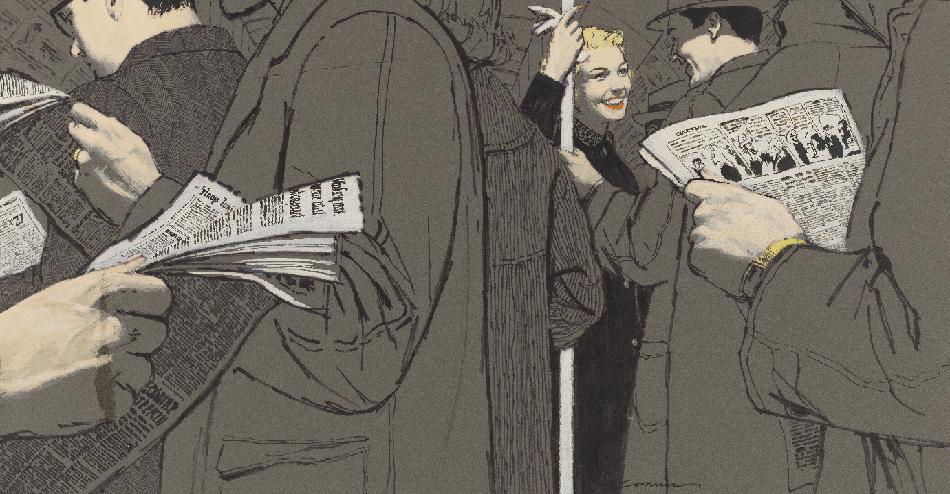 Illustration for “The Girl Who Was Crazy About Jimmy Durante” in Woman’s Day, September 1953, Gouache and ink on illustration board © Mac Conner. Courtesy of the artist
Illustration for “The Girl Who Was Crazy About Jimmy Durante” in Woman’s Day, September 1953, Gouache and ink on illustration board © Mac Conner. Courtesy of the artist
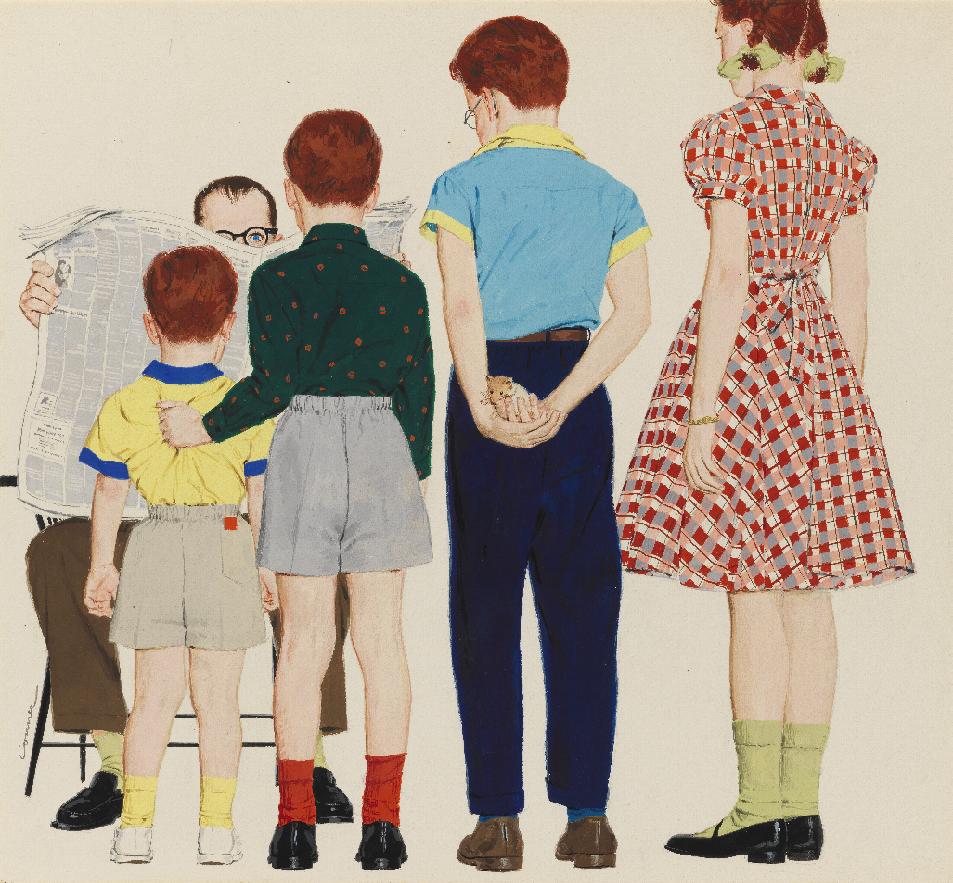 Illustration for “We Won’t Be Any Trouble” in Collier’s, November 13, 1953, Gouache on illustration board © Mac Conner. Courtesy of the artist
Illustration for “We Won’t Be Any Trouble” in Collier’s, November 13, 1953, Gouache on illustration board © Mac Conner. Courtesy of the artist
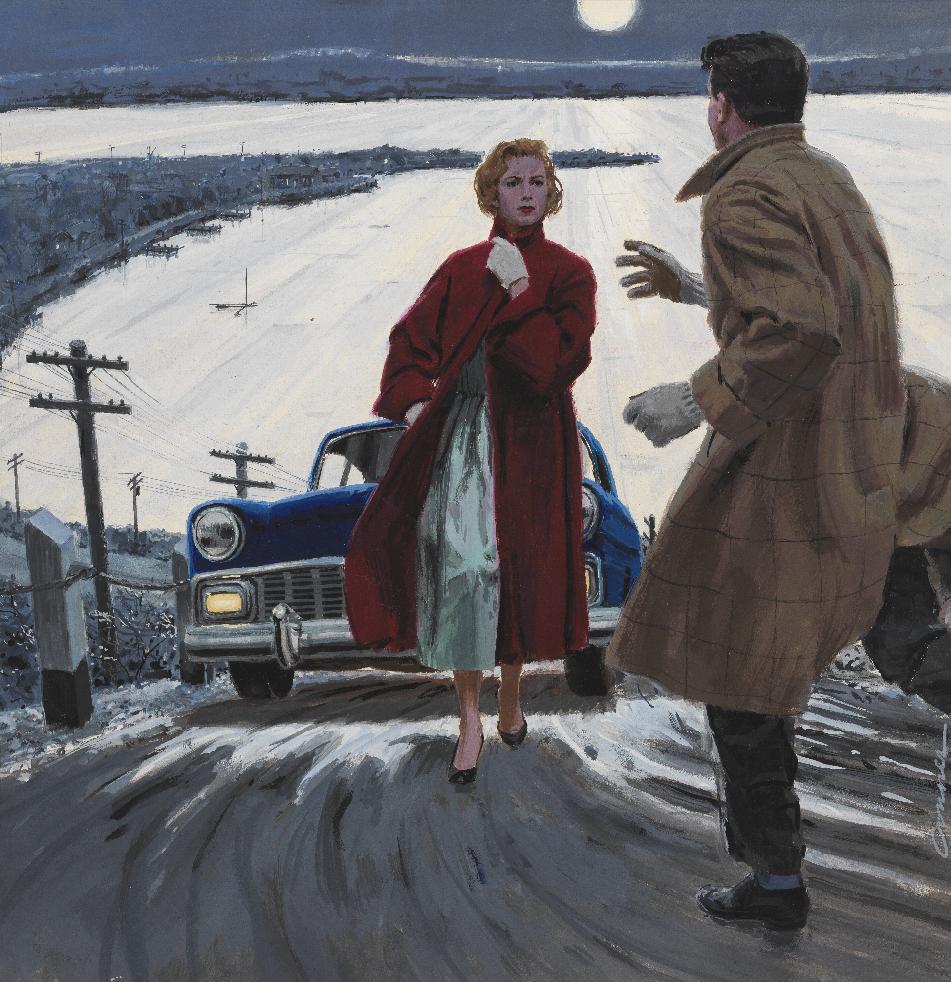 Illustration for “Hold On Tight” in Redbook, March 1958, Gouache on illustration board © Mac Conner. Courtesy of the artist
Illustration for “Hold On Tight” in Redbook, March 1958, Gouache on illustration board © Mac Conner. Courtesy of the artist
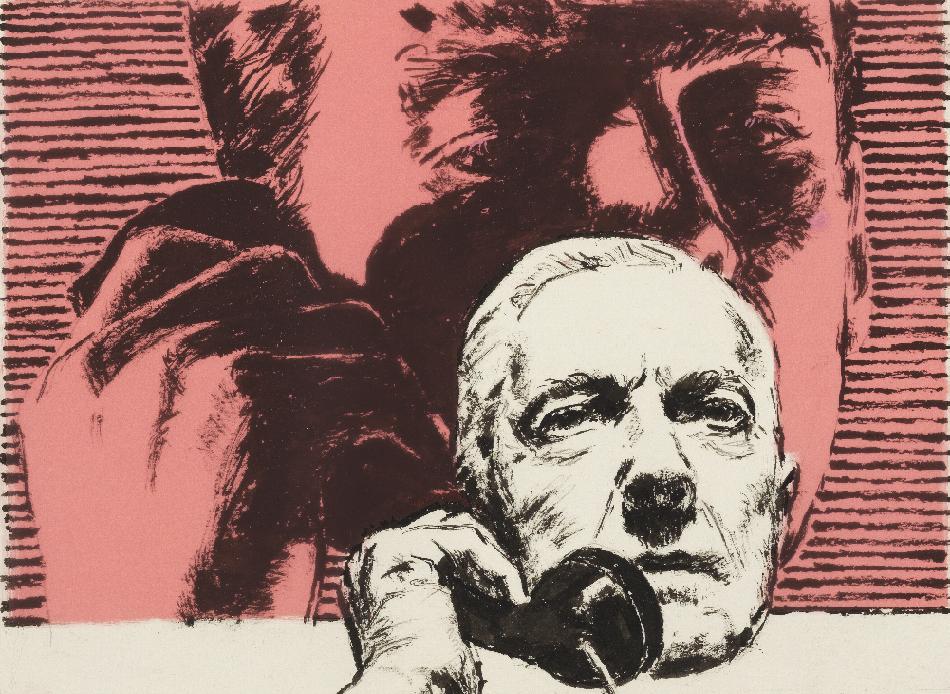 Illustration for “Extortion” in This Week Magazine, April 24, 1955, Ink and acetate on illustration board © Mac Conner. Courtesy of the artist
Illustration for “Extortion” in This Week Magazine, April 24, 1955, Ink and acetate on illustration board © Mac Conner. Courtesy of the artist
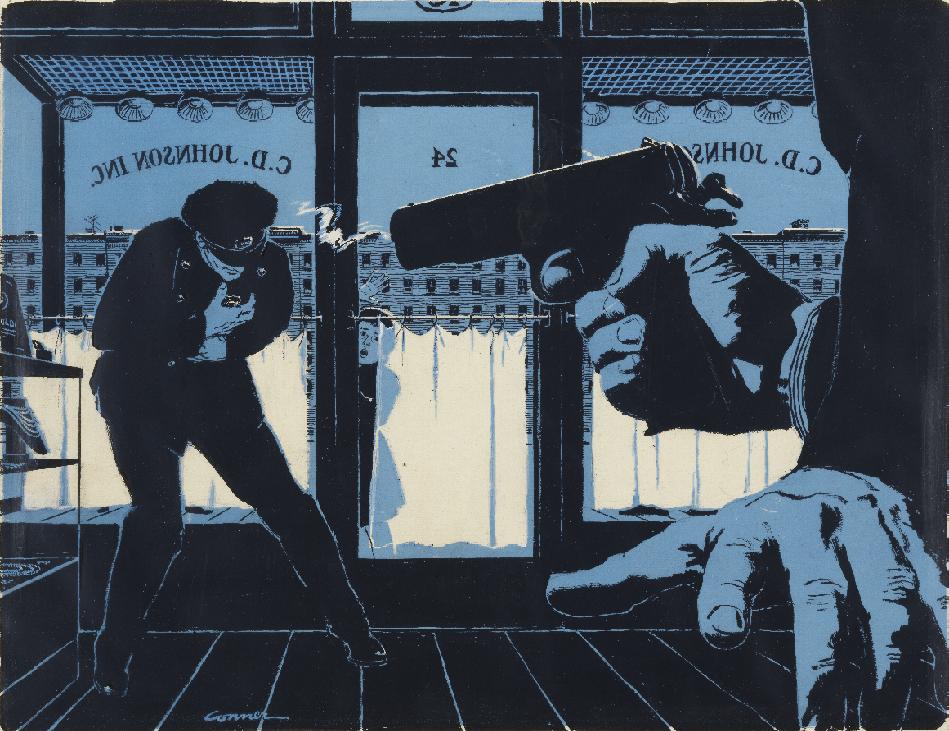 Illustration for “Killer in the Club Car” in This Week Magazine, November 14, 1954, Ink and acetate on illustration board © Mac Conner. Courtesy of the artist
Illustration for “Killer in the Club Car” in This Week Magazine, November 14, 1954, Ink and acetate on illustration board © Mac Conner. Courtesy of the artist
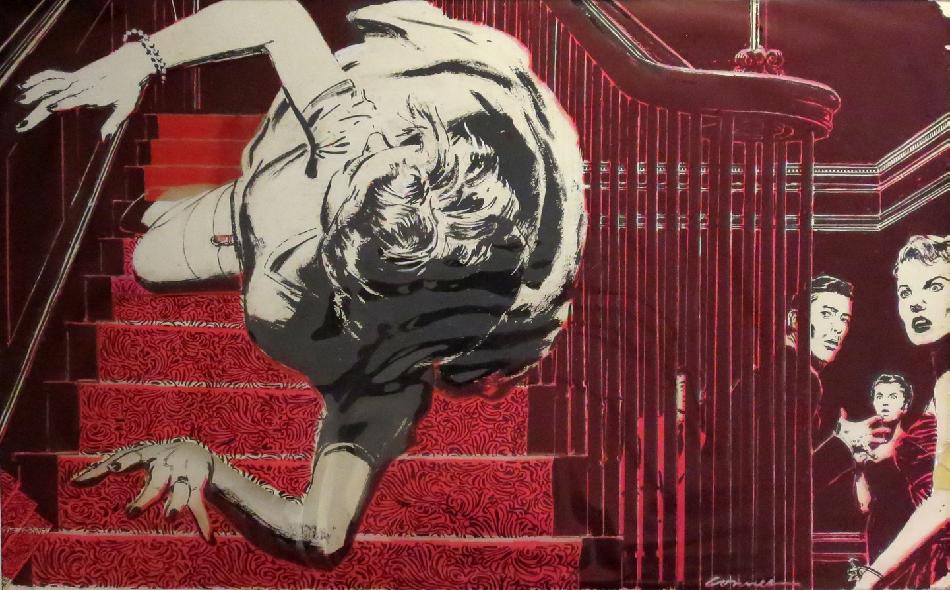 Illustration for “There’s Death For Remembrance” in This Week magazine, November 13, 1953, Gouache and ink on illustration board © Mac Conner. Courtesy of the artist
Illustration for “There’s Death For Remembrance” in This Week magazine, November 13, 1953, Gouache and ink on illustration board © Mac Conner. Courtesy of the artist
 Illustration for “Dr. Garvey’s ‘Other Woman'” in This Week Magazine, September 4, 1955, Gouache and ink on illustration board © Mac Conner. Courtesy of the artist
Illustration for “Dr. Garvey’s ‘Other Woman'” in This Week Magazine, September 4, 1955, Gouache and ink on illustration board © Mac Conner. Courtesy of the artist
ORGANIZER
The Original Mad an: Illustrations by Mac Conner was developed by the Museum of the City of New York
SPONSORS
Co-sponsored by the Modern Graphic History Library, Washington University in St. Louis, the Rockwell Center for American Visual Studies, and the Norman Rockwell Museum. This exhibition is made possible by the Edgar A. Thronson Foundation Illustration Exhibition Fund. Additional support was provided, in part, by a grant from the Delaware Division of the Arts, a state agency, in partnership with the National Endowment for the Arts. The Division promotes Delaware arts events on www.DelawareScene.com
DELAWARE ART MUSEUM
2301 Kentmere Parkway, Wilmington, Delaware 19806
302.571.9590 | 866.232.3714 (Toll free)
http://www.delart.org/

About Delaware Art Museum
A commitment to American illustrators
 When celebrated American artist and illustrator Howard Pyle, a Wilmington, Delaware, native, died unexpectedly in November of 1911, his tragic death galvanized his supporters and sparked the creation of what would become the Delaware Art Museum. For 100 years, the Museum has occupied a vibrant place in the life of the Brandywine Valley.
When celebrated American artist and illustrator Howard Pyle, a Wilmington, Delaware, native, died unexpectedly in November of 1911, his tragic death galvanized his supporters and sparked the creation of what would become the Delaware Art Museum. For 100 years, the Museum has occupied a vibrant place in the life of the Brandywine Valley.
More than a collection of beautiful objects, the Museum is a vital source of experiences, discoveries, and activities. From the start, the Museum was envisioned as a community project. On a cold evening in the early winter of 1912, a small, diverse group of Delaware residents gathered. Some were artists; others were entrepreneurs, business pioneers, and community leaders.
All were good friends of Howard Pyle, who had put Wilmington on the artistic map with his inspired artworks and impassioned teaching. When he died at the age of 58 during a family trip to Italy, Pyle left behind a legion of grieving students, friends, and admirers.
The saddened gathering decided on that winter evening that something must be done to honor the man who had touched them all so deeply. The group formed the Wilmington Society of the Fine Arts, and generous donations from local patrons enabled them to purchase from Pyle’s widow a group of the artist’s most important works.
When the charter of the Society was drawn in 1912, it boasted the signatures of Delaware luminaries such as Louisa du Pont Copeland and illustrators Stanley M. Arthurs and Frank E. Schoonover. More importantly, it stated a broad vision “to promote the knowledge and enjoyment of and cultivation in the fine arts in the State of Delaware.”
Those first Pyle paintings and drawings formed the foundation of a collection that would grow to include works by Pyle’s students, many of whom became leading American illustrators. The Society’s collection was soon recognized as a primary repository for original paintings and archival documents from the Golden Age of American Illustration (1880–1914).
In its first years, the Society held a wide variety of exhibitions, first in the Hotel duPont and then in the Wilmington Free Library on Rodney Square. In addition to prominently featuring Delaware artists and students of Howard Pyle, the Society presented artwork of Old Masters, French Impressionists, American antiques, and Russian paintings.
The momentum of the Bancrof family
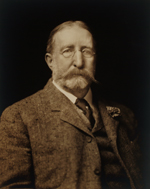 In the early 1930s, the Society’s holdings were expanded when it was offered another unparalleled collection, this time a major holding of English art. Samuel Bancroft, Jr. (1840–1915), a Wilmington textile mill owner, had been “shocked with delight” upon viewing his first Pre-Raphaelite painting in 1880. His decision to collect Pre-Raphaelite art was highly unusual, both within the local community and in the United States, because the British Pre-Raphaelite artists were considered to be a radical art group. By his death in 1915, Bancroft had assembled a major collection, which has become the largest and most significant Pre-Raphaelite holding outside the United Kingdom.
In the early 1930s, the Society’s holdings were expanded when it was offered another unparalleled collection, this time a major holding of English art. Samuel Bancroft, Jr. (1840–1915), a Wilmington textile mill owner, had been “shocked with delight” upon viewing his first Pre-Raphaelite painting in 1880. His decision to collect Pre-Raphaelite art was highly unusual, both within the local community and in the United States, because the British Pre-Raphaelite artists were considered to be a radical art group. By his death in 1915, Bancroft had assembled a major collection, which has become the largest and most significant Pre-Raphaelite holding outside the United Kingdom.
Samuel Bancroft’s family donated his artworks and manuscript collection to the Wilmington Society of the Fine Arts in 1935. They also donated 11 acres of gently rolling countryside near Kentmere Parkway in Wilmington with the provision that a museum be built on the site to house the Bancroft Collection. As a testament to both the dedication and generosity of the Society and its community supporters, $350,000 was raised during the Great Depression for museum construction and its endowment. In June 1938, the newly named Delaware Art Center opened to the public with galleries devoted to the British Pre-Raphaelites, Howard Pyle and his students, and a growing collection of American art.
With its core collections now established, the Center declared a more ambitious mission—to collect, preserve, and interpret fine arts for the benefit of the public and become a leading arts center for the region. A number of groups, including the Camera Club, the Wilmington Academy of Art, and the Junior League of Wilmington occupied its spaces, held meetings, and participated in the Center’s programs.
When the Wilmington Academy of Art closed its doors in 1943, the Delaware Art Center took over its classes and programs. By 1954, nearly 500 students a year were taking part in a wide variety of studio art courses. The mission of arts education, bolstered by the overwhelming success of these programs, was further strengthened in the 1950s by a bequest from H. Fletcher Brown, a distinguished philanthropist. His gift funded the construction of new studios and classrooms at the Center, and the H. Fletcher Brown Education Wing opened to the public in 1956.
The ambitious schedule of educational programming that was established continues today. The Museum still offers Studio Art Classes for children and adults, as well as concerts, lectures, symposia, films, children’s programs, family programs, tours, and extensive community outreach services.
The Museum’s art collection also grew steadily in size and influence. Important works of art were added to both the Pre-Raphaelite and Illustration collections, and a renewed emphasis on 19th- and 20th-century American artists began to take shape. Major works by Frederic Edwin Church, Winslow Homer, Edward Hopper, Andrew Wyeth, and Paul Cadmus were all added to the collection in the 1950s and 1960s.
The contribution of Helen Farr Sloan
![Helen [Farr Sloan] at the Easel - 1947](https://patrons.org.es/wp-content/uploads/2017/05/Helen-Farr-Sloan-at-the-Easel-1947.jpg) The interest and patronage of Helen Farr Sloan was instrumental to the growth of the American collections. Following the death of her husband John Sloan (one of the premier American artists of the 20th century) in 1951, Mrs. Sloan turned the artist’s estate into an exceptional philanthropic tool to serve local, regional, national, and international constituencies.
The interest and patronage of Helen Farr Sloan was instrumental to the growth of the American collections. Following the death of her husband John Sloan (one of the premier American artists of the 20th century) in 1951, Mrs. Sloan turned the artist’s estate into an exceptional philanthropic tool to serve local, regional, national, and international constituencies.
Helen Farr Sloan first visited Wilmington in 1960 to help organize an exhibition titled The Fiftieth Anniversary of the Exhibition of Independent Artists in 1910. Impressed with the Museum’s collection and staff, as well as its dedication to collecting and exhibiting American Art, Mrs. Sloan nurtured a special relationship with the organization.
Because of her gifts and scholarship, the Museum received more than 5,000 artworks, including the preeminent collection of John Sloan’s oeuvre and archive, with virtually every aspect of his career represented, making the Delaware Art Center the leading repository for the study of John Sloan.
In 1972, the institution was one of the first institutions of its size to be awarded accreditation by the American Association of Museums (now the American Alliance of Museums). Shortly after achieving accreditation, the Delaware Art Center was renamed the Delaware Art Museum to reflect the growing strength of its collections, programs, and constituency.
It was clear that the Center had evolved into an institution of national and international importance. In more recent years, two major expansions of the Museum were undertaken to accommodate the increasing requirements of its ever-growing collections, exhibitions, and programs. In 1987, the Museum opened the 20,000-square-foot Pamela and Lammot duPont Copeland Wing.
This much-needed addition doubled the exhibition space and saw the dedication of an expanded library named in honor of Helen Farr Sloan. The following year, the Museum won the prestigious Delaware Governor’s Award for the Arts in honor of its contributions to civic and artistic life of the community.
The 21st century
The arrival of the 21st century saw a renewed commitment to enhance the strengths of the Museum. At that time,contemporary American artists began to share the spotlight in the Museum’s increasingly inclusive collection. Works by contemporary masters such as Robert Motherwell, George Segal, and Jim Dine were all added to the growing collection near the turn of the century. This continuing commitment to the proper stewardship of the Museum’s fine collections and the need to host substantial exhibitions and educational programs sparked another expansion.
 The newly reconfigured Delaware Art Museum, designed by Boston-based Ann Beha Architects, opened in 2005. It featured not only new galleries, but the six-acre Copeland Sculpture Garden, the first in the region.
The newly reconfigured Delaware Art Museum, designed by Boston-based Ann Beha Architects, opened in 2005. It featured not only new galleries, but the six-acre Copeland Sculpture Garden, the first in the region.
Over 5,000 people attended the much-anticipated opening of the new building. With its increasing presence throughout the state and the region, the Delaware Art Museum continues to strengthen both its collections and its commitment to the community.
In 2008, noted contemporary art collectors Herbert and Dorothy Vogel gave 50 works of minimal and conceptual art and traveled from New York to participate in the opening celebrations. The next year, the Museum acquired the Alfred Appel, Jr. collection of art by Leonard Baskin, and the donors were once again involved in the opening and programs.
The Museum’s charge in the coming millennium is to continue its mission as an essential resource for all and advocate for the rightful place of art in strengthening our society. As the Museum’s collections continue to grow and its exhibitions and programs continue to unfold, the vision of the founders grows ever more relevant and powerful: to connect the community through and with art.